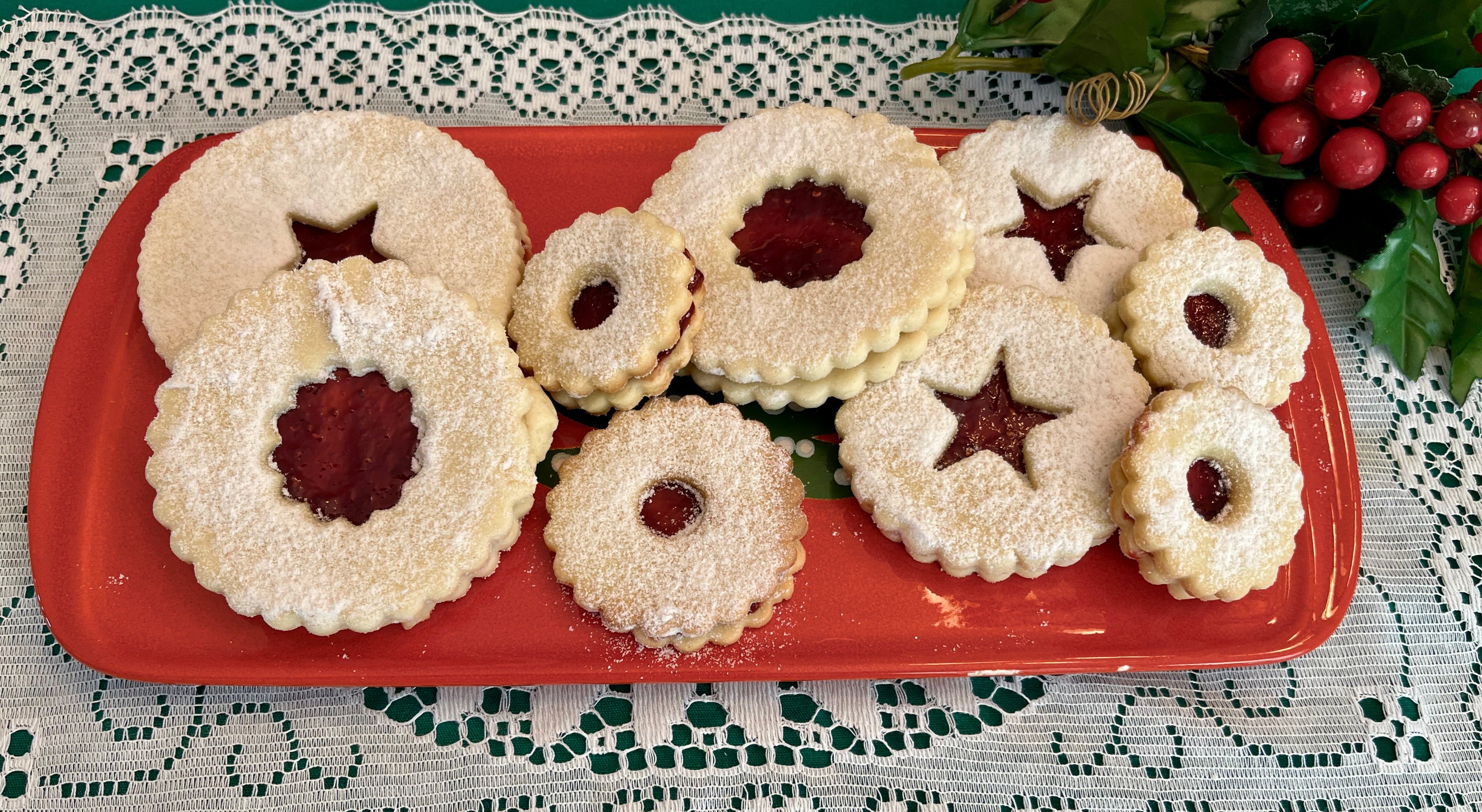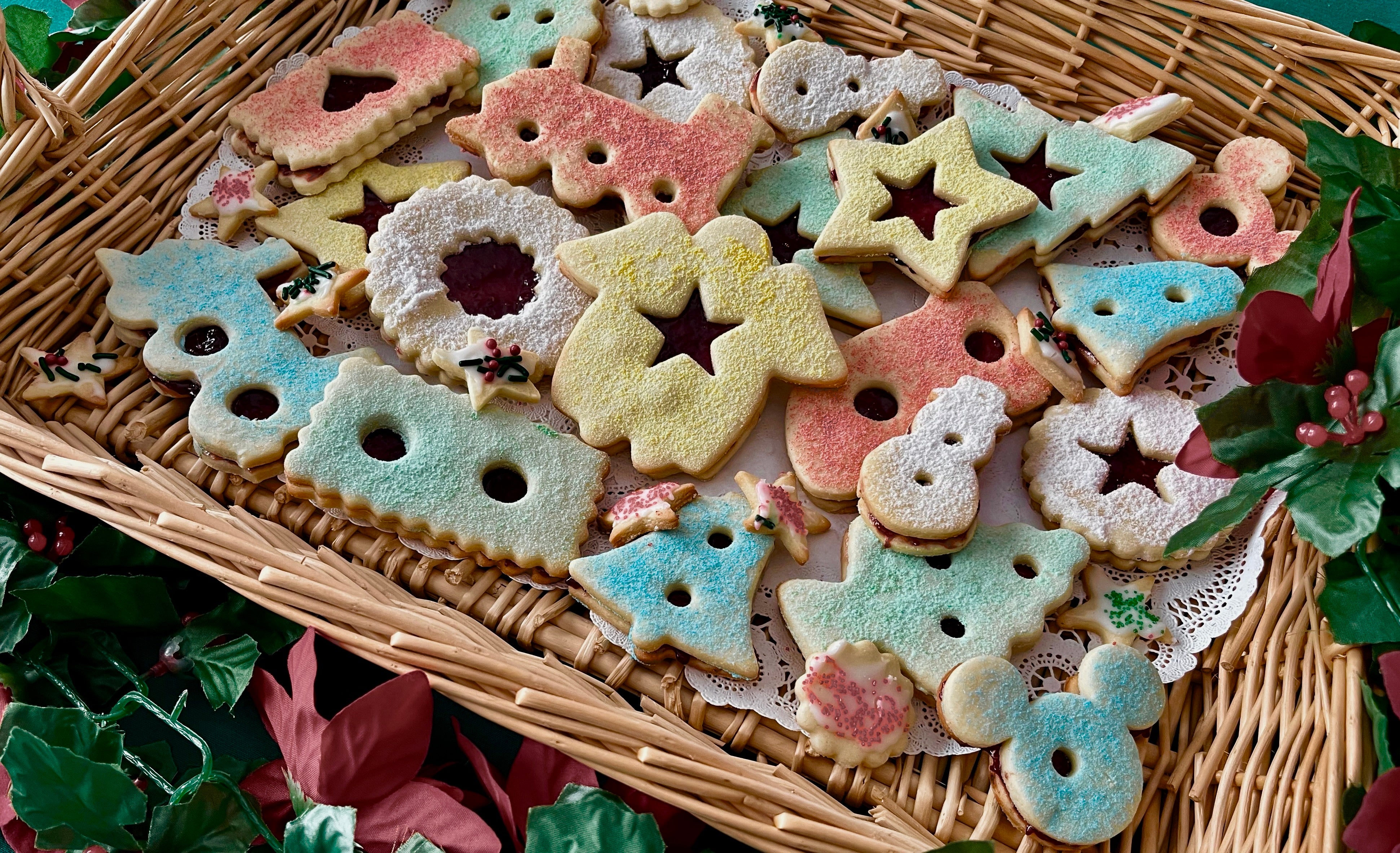Life in our Foothills December 2022 – It Wouldn’t Be Christmas Without Cookies
Published 11:34 am Thursday, December 22, 2022
|
Getting your Trinity Audio player ready...
|
The Austrian Linzer Cookie is the cookie of Christmas this year. It’s showing up everywhere, in catalogs, cooking columns, and even in cozy Hallmark Christmas movies. Are you wondering where it came from, how it tastes, and how to make it? Let’s learn about the Linzer, the cookie that is taking over cookie baking in 2022.
The world’s oldest written recipe, still in existence, is the Austrian Linzertorte. The recipe dates to 1653 when discovered in the cookery manuscript of Countess Anna Margarita Sagramosa of Austria. It was a tart, baked like a pie with a delicious buttery almond crust, filled with black currant preserves, and topped with a latticework crust.
Eventually, a cookie version was developed in Linz. Bakers could easily sell them in their shops. The cookies were cut into shapes such as stars, circles or hearts. The top cookie would get second cutouts in the center. Once baked, they’re made into a sandwich cookie. The bottom is smeared with a filling like seedless raspberry or strawberry jam. After placing the cut-out version on top, the cookie is sprinkled with powdered sugar, with the jam peeking through the sugary top. They almost look dusted with new-fallen snow.
Austrian and German immigrants, who traveled to America, brought the recipe and the tradition of Linzer cookies to their new country. When the musical family, the Von Trapps, of “Sound of Music” fame, came to Stowe, Vermont, their Austrian holiday Linzertorte recipes came with them. The largest collection of historical Linzer torte recipes is housed in a museum in Upper Austria. Many variations can be found in cookbooks and dessert recipe books, each one a little different. Everyone has their own favorite recipe.

Original Linzer Cookie recipes called for almond flour or almond extract. The first recipe that I discovered was in Southern Living magazine. It calls for both vanilla and almond extract. Since we are “Two Sisters Who Cook,” we played around with a few different recipes until we developed our favorite. We prefer lemon extract to almond. We’re offering the recipe that we enjoy. The base is more of a shortbread than some of the recipes we tried. If you prefer a traditional Linzer recipe, several options can be found on the internet.
The tradition of Christmas cookies goes back to the monasteries of the middle ages where monks had access to sugar and the spices we now associate with Christmas cookies including cinnamon, cloves, ginger, and cardamom. Gingerbread cookies are the world’s most famous holiday cookies. Gingerbread was sold at medieval European festivals, fairs and monasteries. In Germany, Gingerbread cookies can be ordered for the festive holiday in large decorative tins. In the United States, the Peanut Butter Blossom, the peanut butter cookie with a Hershey’s kiss dropped into the middle of the cookie, is rated most popular.
Different countries all have their favorite cookie that is prevalent at the holidays. Scotland is known for shortbread. The Brits love stained glass cookies, made with melted hard candy pieces set in the center of the cookie. France offers Madeleines, a petite cake scented with vanilla and orange zest. Puerto Rican Besitos de Coco (Coconut Kisses) are dressed up with crushed nuts and chocolate drizzle. Mexican Wedding Cookies are butter-type cookies making a wonderful addition to any Christmas cookie platter. Italian Pizzelle cookies look like little lace doilies. They’re made with a special waffle iron, and the batter for this recipe is flavored with anise.
As a child, sugar cookies were traditional in our kitchen. In early December, we’d dig out the Christmas Cookie cutters resembling Santa Claus, stars, bells, and Christmas trees. We’d take turns rolling out the dough and cutting out the shapes. The fun started when we made colored frosting and began to decorate our cutout cookies. Hopefully one would break as we spread the frosting. The broken ones were devoured immediately.
It’s just not Christmas without the cookies. Do you have a cookie exchange to attend? Wondering what to serve for dessert at a gala gathering? And don’t forget about Santa and the reindeer. The Linzer Cookie will be enjoyed by all.

Linzer Butter Cookies
Before mixing up your batter and preparing to bake your cookies, you need to think about the cutouts. Miniature cutters in different shapes and sizes can be purchased. A substitute for purchasing shapes is to use a small jar cap or a plastic straw. They can be used to make circular cutouts. Using a straw to cut out small holes on the Christmas tree results in red jam showing through the cookie, resembling round ornaments hanging on the tree. We also discovered some Smuckers’ raspberry jam in a green squeeze bottle, which works perfectly for spreading jam on the cookie. The little cutouts can also be baked and dipped in confectioners sugar for decorating.
As we chose which cookie cutters to use we decided to become a little less traditional and color some of the cookies with colored powdered sugar. Using gel food coloring, place about a cup of powdered sugar in your food processor. Squirt some gel on top and run the food processor for at least 30 seconds. For stronger color, add more gel and run again.
Ingredients
1 1/4 cups confectioners’ sugar
18 tablespoons salted butter, room temperature
1 large egg yolk
1/2 tsp lemon or vanilla extract
1/2 teaspoon salt
2 3/4 cups All-Purpose Flour
Instructions
- Combine the sugar, butter, egg yolk, salt, and flavor, beating until smooth. Add the flour, mixing until smooth. The mixture will seem dry at first, but will suddenly come together. If it doesn’t, dribble in a tablespoon of water.
- Divide the dough in half, shape each half into a flattened disk, and wrap in plastic. Refrigerate for 2 hours, or overnight. When you’re ready to bake, remove the dough from the refrigerator, and let it soften for about 20 to 30 minutes, until it feels soft enough to roll. It should still feel cold, but shouldn’t feel rock-hard.
- Sprinkle your rolling surface with flour, and flour your rolling pin. Working with one piece of dough at a time, roll it 1/8” thick. Use a cookie cutter to cut shapes. Re-roll and cut the dough scraps. Place the cookies on an ungreased or parchment-lined baking sheet. They can be close together; they’ll barely spread. Prepare a second baking sheet. Cut out cookies. Then use a miniature cutter and cut out a shape in the center of the cookie. Have an equal number of cookies on each sheet as these will become the top and bottom of each cookie.
- Bake the cookies in a preheated 350°F oven for 12 to 14 minutes, until they’re set and barely browned around the edges.
- Remove the cookies from the oven, and cool right on the pan. If you’ve used parchment, you can lift cookies and parchment off the pan, so you can continue to use the pan as the cookies cool.
- Repeat with the remaining piece of dough, rolling, cutting, and baking cookies. Be sure to have an equal number of tops and bottoms of each shape.
- When cool, spread jam on each bottom cookie. Place cutout cookie on top so jam shows through the center cutout.
- Using a small strainer, dust cookies with powdered sugar.






